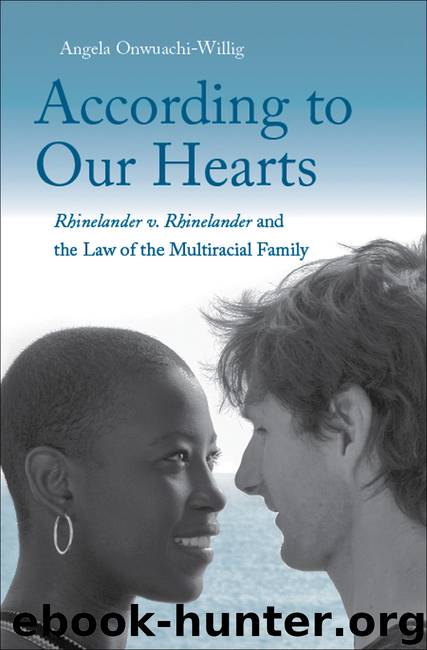According to Our Hearts by Angela Onwuachi-Willig & Rhinelander V. Rhinelander

Author:Angela Onwuachi-Willig & Rhinelander V. Rhinelander
Language: eng
Format: epub
Publisher: Yale University Press
Published: 2013-04-11T04:00:00+00:00
As the above list demonstrates, even in a post–Loving v. Virginia world, black-white, heterosexual couples encounter discrimination at the intersection of race and family. This discrimination works to mark them as being outside the normative family ideal, an ideal, which through social and even legal cues, gets defined as not just heterosexual but also monoracial. For many black-white, heterosexual couples, the interraciality of their family tends to make their very existence as a couple invisible and places many of the privileges that generally attach to same-race, heterosexual couples and families outside of their reach.
Indeed, some of my social experiences with my husband as well as those of other black-white couples, such as those in my survey, confirm this reality. Consider just a few of the examples from all of the lists of privileges above. For instance, as the last list of privileges briefly notes, unlike for single-race, white heterosexual couples, fear of mistreatment plays a role for many black-white, heterosexual couples when choosing public accommodations. In our own experience, my husband, Jacob, and I usually try to carefully plan where we will eat, play, or stay overnight as a means of avoiding discrimination on the road.23 At times, we even “game” the system, sending Jacob, who is white, in first to scope out the premises or to check us in at a hotel. As Suffolk University Law School Dean Camille Nelson, a black woman who is married to a white man, explained in her article “Lovin’ the Man: Examining the Legal Nexus of Irony, Hypocrisy, and Curiosity”: “Navigation of the public space, versus the private sanctuary, is an issue requiring some deliberation on the part of many interracial couples. Like other racialized couples, my partner and I do not have the luxury of simply venturing where we might—we often reflect upon whether certain venues will be welcoming, comfortable, or safe.”24 Indeed, in those instances when black-white couples fail to engage in such deliberate thinking about which spaces are welcome, they may find themselves encountering unwelcome reminders about why they still must engage in such planning. For instance, consider this experience by Jim, a white man who is married to a biracial, black-white woman. On the return drive from his family vacation, Jim found himself surprised by the welcoming and then unwelcoming reaction of a white woman at the Welcome Center in the South. Jim asserted:
Download
This site does not store any files on its server. We only index and link to content provided by other sites. Please contact the content providers to delete copyright contents if any and email us, we'll remove relevant links or contents immediately.
| Anthropology | Archaeology |
| Philosophy | Politics & Government |
| Social Sciences | Sociology |
| Women's Studies |
Nudge - Improving Decisions about Health, Wealth, and Happiness by Thaler Sunstein(7257)
iGen by Jean M. Twenge(5166)
The Fire Next Time by James Baldwin(5024)
Adulting by Kelly Williams Brown(4240)
The Hacking of the American Mind by Robert H. Lustig(4092)
The Sports Rules Book by Human Kinetics(4079)
The Ethical Slut by Janet W. Hardy(4042)
Captivate by Vanessa Van Edwards(3732)
Mummy Knew by Lisa James(3522)
In a Sunburned Country by Bill Bryson(3374)
The Worm at the Core by Sheldon Solomon(3327)
Ants Among Elephants by Sujatha Gidla(3282)
Suicide: A Study in Sociology by Emile Durkheim(2908)
The Slow Fix: Solve Problems, Work Smarter, and Live Better In a World Addicted to Speed by Carl Honore(2843)
The 48 laws of power by Robert Greene & Joost Elffers(2817)
Humans of New York by Brandon Stanton(2690)
Handbook of Forensic Sociology and Psychology by Stephen J. Morewitz & Mark L. Goldstein(2605)
The Happy Hooker by Xaviera Hollander(2586)
The Tipping Point by Malcolm Gladwell(2563)
